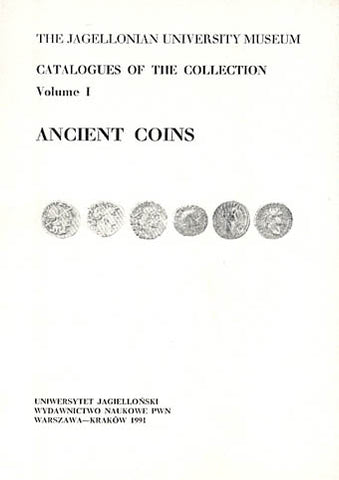The Jagiellonian University Museum, Catalogues of the Collection, Volume I, ANCIENT COINS, Part 1, Coins of the Roman Republic, Part 2, Coins of the Roman Empire, Augustus-Domitianus
35,00 $
ISBN: 83-01-10245-4
Description: 93 pages, 190 b&w photographs
Condition: very good
Weight: 220g.
The Jagiellonian University Museum, Catalogues of the Collection, Volume I, ANCIENT COINS, Part 1, Coins of the Roman Republic, Part 2, Coins of the Roman Empire, Augustus-Domitianus, Jagiellonian University Press 1991
An Outline History of the Coin Collection of the Jagellonian University Museum
Introduction to the Catalogue
Abbreviations
Catalogue: Part 1. Coins of the Roman Republic
Indices
Catalogue: Part 2. Coins of the Roman Empire
Indices
Plates
The present catalogue constitutes the first part of a publication which is going to list the whole inventory of acquired of ancient coins in the possesion of the Jagellonian University Museum. It describes 71 coins of the Roman Republic dating from 225 to 31 B. C. in the first part and, in the second, 192 coins of ihe early Roman Empire (from Augustus to Domitian).
Most of the coins presented in this volume come from the former collection of the Jagellonian Library (241 specimens), 19 coins came from the collection of the Cabinet of Archaeology, moreover, 1 coin was donated by the Academy of Sciences and Letters in Cracow and 2 coins came from other donations.
Among the coins of the Roman Republic included in the first part of the catalogue, the oldest are the didrachms called qt/adrigati with a characteristic representation of a quadriga with Jupiter and Victory on the reverse (pos. 1 and 2). There is presently a controversy over the date of this emission. The opinion hitherto accepted up till now has connected the appearance of the first quadrigati with the last emission of libral aes grave ("ship's prow") but the opinions of particular investigators varyl. Recently P. Marchetii suggested that they had appeared exactly at the time when the semilibral reduction was introduced, i.e., in 225 B. C. * It is widely believed, however, that the emission of the quadrigati stopped simultaneously with the introduction of denarii, i.e.. in the years 214 to 211 B. C.3 Moreover, the 3rd century is represented by 14 bronze coins of various nominals and 1 victoriat. The 2nd century B. C. is represented in the catalogue by 20 coins: 3 bronze and 17 denarii, including, among others, 1 denarius subaeratus.
Description: 93 pages, 190 b&w photographs
Condition: very good
Weight: 220g.
The Jagiellonian University Museum, Catalogues of the Collection, Volume I, ANCIENT COINS, Part 1, Coins of the Roman Republic, Part 2, Coins of the Roman Empire, Augustus-Domitianus, Jagiellonian University Press 1991
An Outline History of the Coin Collection of the Jagellonian University Museum
Introduction to the Catalogue
Abbreviations
Catalogue: Part 1. Coins of the Roman Republic
Indices
Catalogue: Part 2. Coins of the Roman Empire
Indices
Plates
The present catalogue constitutes the first part of a publication which is going to list the whole inventory of acquired of ancient coins in the possesion of the Jagellonian University Museum. It describes 71 coins of the Roman Republic dating from 225 to 31 B. C. in the first part and, in the second, 192 coins of ihe early Roman Empire (from Augustus to Domitian).
Most of the coins presented in this volume come from the former collection of the Jagellonian Library (241 specimens), 19 coins came from the collection of the Cabinet of Archaeology, moreover, 1 coin was donated by the Academy of Sciences and Letters in Cracow and 2 coins came from other donations.
Among the coins of the Roman Republic included in the first part of the catalogue, the oldest are the didrachms called qt/adrigati with a characteristic representation of a quadriga with Jupiter and Victory on the reverse (pos. 1 and 2). There is presently a controversy over the date of this emission. The opinion hitherto accepted up till now has connected the appearance of the first quadrigati with the last emission of libral aes grave ("ship's prow") but the opinions of particular investigators varyl. Recently P. Marchetii suggested that they had appeared exactly at the time when the semilibral reduction was introduced, i.e., in 225 B. C. * It is widely believed, however, that the emission of the quadrigati stopped simultaneously with the introduction of denarii, i.e.. in the years 214 to 211 B. C.3 Moreover, the 3rd century is represented by 14 bronze coins of various nominals and 1 victoriat. The 2nd century B. C. is represented in the catalogue by 20 coins: 3 bronze and 17 denarii, including, among others, 1 denarius subaeratus.













